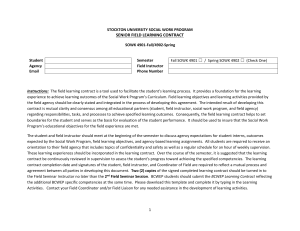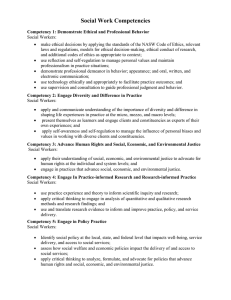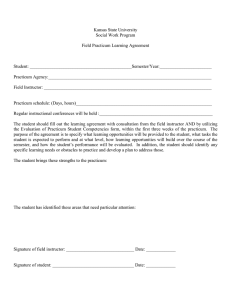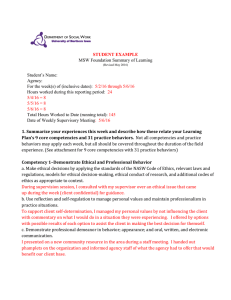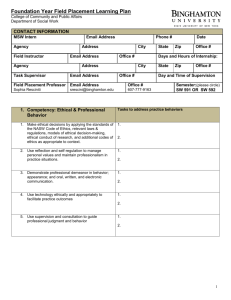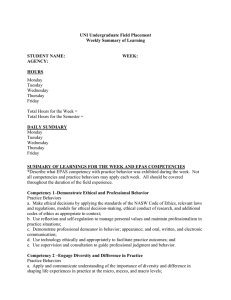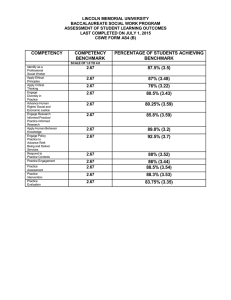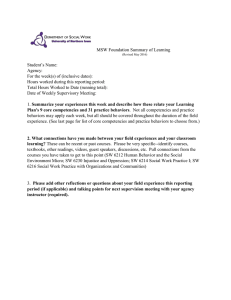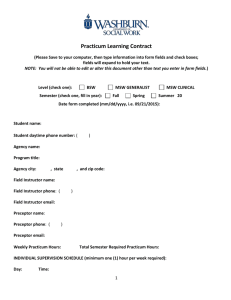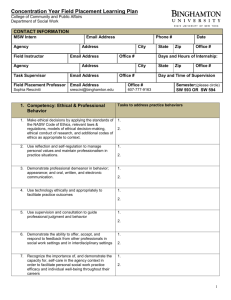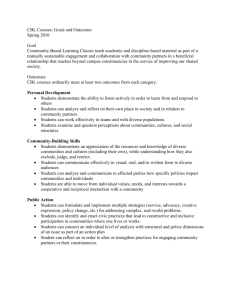MSW F S W
advertisement
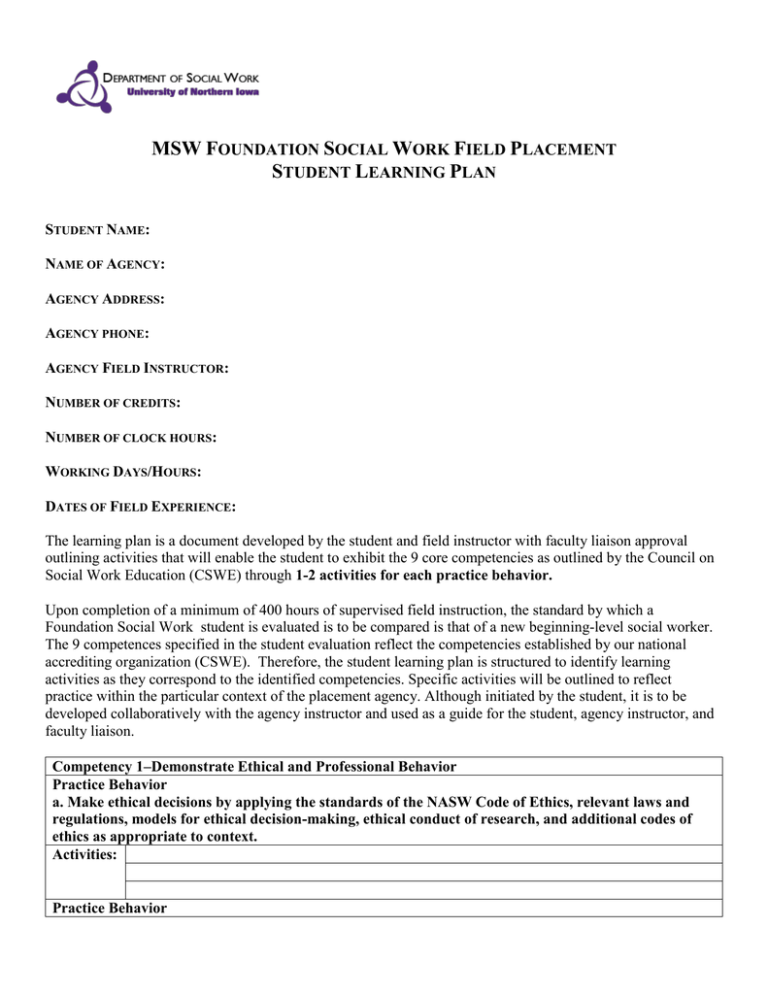
MSW FOUNDATION SOCIAL WORK FIELD PLACEMENT STUDENT LEARNING PLAN STUDENT NAME: NAME OF AGENCY: AGENCY ADDRESS: AGENCY PHONE: AGENCY FIELD INSTRUCTOR: NUMBER OF CREDITS: NUMBER OF CLOCK HOURS: WORKING DAYS/HOURS: DATES OF FIELD EXPERIENCE: The learning plan is a document developed by the student and field instructor with faculty liaison approval outlining activities that will enable the student to exhibit the 9 core competencies as outlined by the Council on Social Work Education (CSWE) through 1-2 activities for each practice behavior. Upon completion of a minimum of 400 hours of supervised field instruction, the standard by which a Foundation Social Work student is evaluated is to be compared is that of a new beginning-level social worker. The 9 competences specified in the student evaluation reflect the competencies established by our national accrediting organization (CSWE). Therefore, the student learning plan is structured to identify learning activities as they correspond to the identified competencies. Specific activities will be outlined to reflect practice within the particular context of the placement agency. Although initiated by the student, it is to be developed collaboratively with the agency instructor and used as a guide for the student, agency instructor, and faculty liaison. Competency 1–Demonstrate Ethical and Professional Behavior Practice Behavior a. Make ethical decisions by applying the standards of the NASW Code of Ethics, relevant laws and regulations, models for ethical decision-making, ethical conduct of research, and additional codes of ethics as appropriate to context. Activities: Practice Behavior b. Use reflection and self-regulation to manage personal values and maintain professionalism in practice situations. Activities: Practice Behavior c. Demonstrate professional demeanor in behavior; appearance; and oral, written, and electronic communication. Activities: Practice Behavior d. Use technology ethically and appropriately to facilitate practice outcomes. Activities: Practice Behavior e. Use supervision and consultation to guide professional judgment and behavior. Activities: Competency 2– Engage Diversity and Difference in Practice Practice Behavior a. Apply and communicate understanding of the importance of diversity and difference in shaping life experiences in practice at the micro, mezzo, and macro levels. Activities: Practice Behavior b. Present themselves as learners and engage clients and constituencies as experts of their own experiences. Activities: Practice Behavior c. Apply self-awareness and self-regulation to manage the influence of personal biases and values in working with diverse clients and constituencies. Activities: Competency 3– Advance Human Rights and Social, Economic, and Environmental Justice Practice Behavior a. Apply their understanding of social, economic, and environmental justice to advocate for human rights at the individual and system levels. Activities: Practice Behavior b. Engage in practices that advance social, economic, and environmental justice. Activities: Competency 4– Engage In Practice-informed Research and Research-informed Practice Practice Behavior a. Use practice experience and theory to inform scientific inquiry and research Activities: Practice Behavior b. Apply critical thinking to engage in analysis of quantitative and qualitative research methods and research findings Activities: Practice Behavior c. Use and translate research evidence to inform and improve practice, policy, and service delivery Activities: Competency 5– Engage in Policy Practice Practice Behavior a. Identify social policy at the local, state, and federal level that impacts well-being, service delivery, and access to social services. Activities: Practice Behavior b. Assess how social welfare and economic policies impact the delivery of and access to social services. Activities: Practice Behavior c. Apply critical thinking to analyze, formulate, and advocate for policies that advance human rights and social, economic, and environmental justice. Activities: Competency 6– Engage with Individuals, Families, Groups, Organizations, and Communities Practice Behavior a. Apply knowledge of human behavior and the social environment, person-in-environment, and other multidisciplinary theoretical frameworks to engage with clients and constituencies. Activities: Practice Behavior b. Use empathy, reflection, and interpersonal skills to effectively engage diverse clients and constituencies. Activities: Competency 7– Assess Individuals, Families, Groups, Organizations, and Communities Practice Behavior a. Collect and organize data, and apply critical thinking to interpret information from clients and constituencies. Activities: Practice Behavior b. Apply knowledge of human behavior and the social environment, person-in-environment, and other multidisciplinary theoretical frameworks in the analysis of assessment data from clients and constituencies. Activities: Practice Behavior c. Develop mutually agreed-on intervention goals and objectives based on the critical assessment of strengths, needs, and challenges within clients and constituencies. Activities: Practice Behavior d. Elect appropriate intervention strategies based on the assessment, research knowledge, and values and preferences of clients and constituencies. Activities: Competency 8– Intervene with Individuals, Families, Groups, Organizations, and Communities Practice Behavior a. Critically choose and implement interventions to achieve practice goals and enhance capacities of clients and constituencies. Activities: Practice Behavior b. Apply knowledge of human behavior and the social environment, person-in-environment, and other multidisciplinary theoretical frameworks in interventions with clients and constituencies. Activities: Practice Behavior c. Use inter-professional collaboration as appropriate to achieve beneficial practice outcomes. Activities: Practice Behavior d. Negotiate, mediate, and advocate with and on behalf of diverse clients and constituencies. Activities: Practice Behavior e. Facilitate effective transitions and endings that advance mutually agreed-on goals. Activities: Competency 9– Evaluate Practice with Individuals, Families, Groups, Organizations, and Communities Practice Behavior a. Select and use appropriate methods for evaluation of outcomes. Activities: Practice Behavior b. Apply knowledge of human behavior and the social environment, person-in-environment, and other multidisciplinary theoretical frameworks in the evaluation of outcomes. Activities: Practice Behavior c. Critically analyze, monitor, and evaluate intervention and program processes and outcomes. Activities: Practice Behavior d. Apply evaluation findings to improve practice effectiveness at the micro, mezzo, and macro levels. Activities: Student Signature Date Field Instructor Signature Date Faculty Liaison Signature Date
